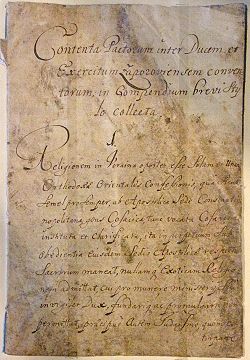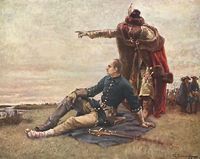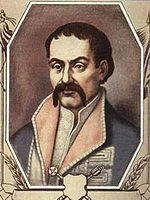- Constitution of Pylyp Orlyk
-
 The first page of the Bendery Constitution. This copy is written in Latin and probably penned by Hetman Pylyp Orlyk. The original is kept in the National Archives of Sweden.
The first page of the Bendery Constitution. This copy is written in Latin and probably penned by Hetman Pylyp Orlyk. The original is kept in the National Archives of Sweden.
The Constitution of Pylyp Orlyk or Pacts and Constitutions of Rights and Freedoms of the Zaporizhian Host (Ukrainian: Конституція Пилипа Орлика (Konstytutsiya Pylypa Orlyka); Пакти і Конституції прав і вольностей Війська Запорозького (Pakty i Konstytutsii Prav i Volnostei Viyska Zaporozkoho), Latin: Pacta et Constitutiones Legum Libertatumque Exercitus Zaporoviensis) was a 1710 constitutional document written by Hetman Pylyp Orlyk.[1] It established a democratic standard for the separation of powers in government between the legislative, executive, and judiciary branches, well before the publication of Montesquieu's Spirit of the Laws. The Constitution also limited the executive authority of the hetman, and established a democratically elected Cossack parliament called the General Council. Pylyp Orlyk's Constitution was unique for its historic period, and was one of the first state constitutions in Europe.
Contents
History
After the Battle of Poltava when Charles XII of Sweden and Hetman Ivan Mazepa armies were defeated by Peter I of Russia, Pylyp Orlyk remained on the side of Mazepa. Together, Orlyk and Mazepa retreated to the city of Bendery, at the time part of the Ottoman Empire. Zaporizhian Cossack Army also settled in this area.
When Ivan Mazepa died on 5 April 1710, Pylyp Orlyk was elected as the Hetman of the Zaporizhia Host. On the same day, Pacts and Constitutions of Rights and Freedoms of the Zaporizhian Host was declared. Hence, Orlyk's Constitution is sometimes referred to by the city of its proclamation - Bendery.
Articles of the Constitution
The document is made up of a preamble[2] and 16 articles [3].
Preamble
The preamble briefly discusses cossack history, the rise and fall of the Zaporizhian Sich after under Bohdan Khmelnytsky it rebelled against the Polish-Lithuanian Commonwealth to serve the Imperial Russia. Using all available means, Moscow limited and nullified rights and freedoms of the Zaporizhian Host going as far as subjugating the free cossack nation, states the introduction. Ivan Mazepa's politics and alliance with Charles XII of Sweden are explained as logical and inevitable, mandated by the need to free the homeland. The independence of the new state from Russia was the primary goal of the Bendery Constitution.
Articles 1 - 5
Articles 1-3 dealt with general Ukrainian affairs. They proclaimed the Orthodox faith to be the faith of Ukraine, and independent of the patriarch of Moscow. The Sluch River was designated as the boundary between Ukraine and Poland. The articles also recognized the need for an anti-Russian alliance between Ukraine and the Crimean Khanate.
Articles 4-5 reflected the interests of the Zaporozhian Cossacks, who constituted the overwhelming majority of the Bendery emigration. The Hetman was obligated:
- to expel, with the help of Charles XII, the Russians from Zaporozhian territories
- to grant the town of Trakhtymyriv to the Zaporozhians to serve as a hospital, and
- to keep non-Zaporozhians away from Zaporozhian territories
Articles 6 - 16
Articles 6-10 limited the powers of the hetman and established a unique Cossack parliament, similar to an extended council of officers, which met three times a year. The General Council was to consist not only of the general staff and the regimental colonels, but also of "an outstanding and worthy individual from each regiment."
Articles 11-16 protected the rights of towns, limited the taxation of peasants and poor Cossacks, and restricted the innkeepers. Charles XII, who was present in Bendery at the time, confirmed these articles, as "the protector of Ukraine."
References
- ^ 300th anniversary of first Ukrainian constitution written by Pylyp Orlyk being celebrated, Kyiv Post (April 5, 2010)
- ^ Mahrytska, Iryna (2005-06-24). "Hetman Pylyp Orlyk and Ukraine's First Constitution". Eastern Ukrainian National University of V. Dalya. Jurisprudentia/Slovo Prosvity. http://www.lawyer.org.ua/?w=r&i=&d=601. Retrieved 2006-08-17.
- ^ "Constitution of Bendery". Internet Encyclopedia of Ukraine, The. Canadian Institute of Ukrainian Studies.
Further reading
- Dogovor i postanovlenie mezhdu Get'manom Orlikom i voiskom Zaporozhskim v 1710, in Chteniia v Imperatorskom obshchestve istorii i drevnostei rossiiskikh (Moscow 1858)
- Krupnyts’kyi, B. Het'man Pylyp Orlyk i ioho politychna diial’nist’ (1672–1742) (Warsaw 1938)
- Vasylenko, M. The Constitution of Pylyp Orlyk, AUA, 6, nos 3-4 (1958)
- Sliusarenko, A. H.; Tomenko, M. V. Istoriia Ukrainskoi Konstytytsii, "Znannia," (Ukraine 1993), ISBN 5-7770-0600-0
External links
- Encyclopedia of Ukraine
- (Ukrainian) Text of the Pylyp Orlik Constitution
- (English) Information about the Constitution
Hetman State Ukrainian People's Republic Ukrainian SSR Constitutions of the Ukrainian Soviet Socialist Republic (1919, 1929, 1937, 1978), Constitution of CrimeaUkraine Categories:- History of Ukraine
- Defunct constitutions
- Constitutions of Ukraine
Wikimedia Foundation. 2010.





